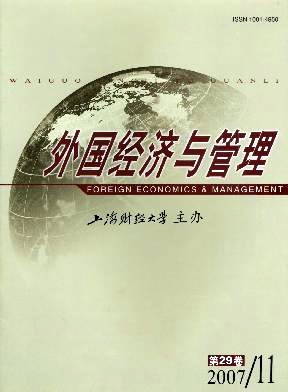基于影响力的柔性领导模型
外国经济与管理 2007 年 第 29 卷第 11 期, 页码:51 - 58
摘要
参考文献
摘要
在知识员工大量涌现而权力、权威逐渐弱化的组织背景下,影响力成为柔性领导行为的核心。与传统领导不同,柔性领导通过潜在、现实和可实现的影响力来提升自身的影响力价值和影响力期权,并通过建立与拓展柔性空间来提升影响力。柔性领导以提升影响力为核心的领导行为导致其领导技能与技巧表现出与传统领导不同的特征。
[1]Gary Yukl,and Richard Lepsinger.Flexible leadership:Creating value by balancing multiple challenges and choices[M].San Francis-co:Jossey-Bass,2004.
[2]Manfred,F R,and Kets de Vries.Organizational paradoxes:Clinical approaches to management[M].London:Tavistock,1994.
[3]John W Thibaut,and Harold H Kelley.The social psychology of groups[M].New York:Wiley,1959.
[4]Dean Tjosvold,Robert Andrews,and John T Struthers.Leadership influence:Goal interdependence and power[J].The Journal ofSocial Psychology,1992,132(1):39-50.
[5]Dean Tjosvold,Robert Andrews,and John T Struthers.Power and interdependence in work groups:Views of managers and employ-ees[J].Group&Organizational Studies,1991,16(3):285-299.
[6]Gary Yukl,and Carolyn Chavez.Influence tactics and leader effectiveness[A].in L Neider,and C Schriesheim(Eds.).Leadership:Research in management[C].Greenwich,Connecticut:Information Age Publishing,2002:139-165.
[7]Andrew J Grimes.Authority power influence and social control:A theoretical synthesis[J].Academy of Management Review,1978,3(4):724-737.
[8]John P Kotter.Find force for change:How leadership differs from management[M].New York:Free Press,1990.
[9]William G Nickels,James M McHugh,and Susan M McHugh.Understanding business[M].7th Ed.New York:McGraw-Hill Col-lege,January 2004.
[10]Allan Calarco,and Joan Gurvis.Adaptability:Responding effectively to change[M].San Francisco:Jossey-Bass,March 2007.
[11]Stephen J Zaccaro,Paige Bader,and Cary Kemp.Leader traits and attributes[A].in J Ankonakis,A T Cianciolo,and R J Sternberg(Eds.).Nature of leadership[C].Oaks,London&New Delhi:Sage,2004.
[12]Kenneth Craik.The nature of explanation[M].Cambridge,England:Cambridge University Press,1943.
[13]Michael J Kirton.A theory of cognitive style[A].in Michael J Kirton(Ed.).Adaptors and innovators:Styles of creativity and prob-lem solving[C].London,England:Routledge,1989:1-33.
[14]Gerard P Hodgkinson.The cognitive analysis of competitive structures:A review and critique[J].Human Relations,1997,50(6):625-654.
[15]Robert Galvin.Managing knowledge towards wisdom[J].European Management Journal,1996,14(4):74-78.
[16]Son,Young Kyu,and Chan S Park.Economic measure of productivity,quality,and flexibility in advanced manufacturing systems[J].Journal of Manufacturing Systems,1987,6(3):193-206.
[17]Patrick M Wright,and Scott A Snell.Toward a unifying framework for exploring fit and flexibility in strategic human resource man-agement[J].Academy of Management Review,1998,23(4):756-772.
[18]Richard Makadok.Toward a synthesis of the resource-based and dynamic-capability views of rent creation[J].Strategic ManagementJournal,2001,22(5):387-401.
[19]Warren G Bennis,and B Nanus.Leaders:The strategy for taking charge[M].New York:Harper and Row,1985.
[20]Hay Group.Law office management&administration report[R].November 2005.
[2]Manfred,F R,and Kets de Vries.Organizational paradoxes:Clinical approaches to management[M].London:Tavistock,1994.
[3]John W Thibaut,and Harold H Kelley.The social psychology of groups[M].New York:Wiley,1959.
[4]Dean Tjosvold,Robert Andrews,and John T Struthers.Leadership influence:Goal interdependence and power[J].The Journal ofSocial Psychology,1992,132(1):39-50.
[5]Dean Tjosvold,Robert Andrews,and John T Struthers.Power and interdependence in work groups:Views of managers and employ-ees[J].Group&Organizational Studies,1991,16(3):285-299.
[6]Gary Yukl,and Carolyn Chavez.Influence tactics and leader effectiveness[A].in L Neider,and C Schriesheim(Eds.).Leadership:Research in management[C].Greenwich,Connecticut:Information Age Publishing,2002:139-165.
[7]Andrew J Grimes.Authority power influence and social control:A theoretical synthesis[J].Academy of Management Review,1978,3(4):724-737.
[8]John P Kotter.Find force for change:How leadership differs from management[M].New York:Free Press,1990.
[9]William G Nickels,James M McHugh,and Susan M McHugh.Understanding business[M].7th Ed.New York:McGraw-Hill Col-lege,January 2004.
[10]Allan Calarco,and Joan Gurvis.Adaptability:Responding effectively to change[M].San Francisco:Jossey-Bass,March 2007.
[11]Stephen J Zaccaro,Paige Bader,and Cary Kemp.Leader traits and attributes[A].in J Ankonakis,A T Cianciolo,and R J Sternberg(Eds.).Nature of leadership[C].Oaks,London&New Delhi:Sage,2004.
[12]Kenneth Craik.The nature of explanation[M].Cambridge,England:Cambridge University Press,1943.
[13]Michael J Kirton.A theory of cognitive style[A].in Michael J Kirton(Ed.).Adaptors and innovators:Styles of creativity and prob-lem solving[C].London,England:Routledge,1989:1-33.
[14]Gerard P Hodgkinson.The cognitive analysis of competitive structures:A review and critique[J].Human Relations,1997,50(6):625-654.
[15]Robert Galvin.Managing knowledge towards wisdom[J].European Management Journal,1996,14(4):74-78.
[16]Son,Young Kyu,and Chan S Park.Economic measure of productivity,quality,and flexibility in advanced manufacturing systems[J].Journal of Manufacturing Systems,1987,6(3):193-206.
[17]Patrick M Wright,and Scott A Snell.Toward a unifying framework for exploring fit and flexibility in strategic human resource man-agement[J].Academy of Management Review,1998,23(4):756-772.
[18]Richard Makadok.Toward a synthesis of the resource-based and dynamic-capability views of rent creation[J].Strategic ManagementJournal,2001,22(5):387-401.
[19]Warren G Bennis,and B Nanus.Leaders:The strategy for taking charge[M].New York:Harper and Row,1985.
[20]Hay Group.Law office management&administration report[R].November 2005.
引用本文
许一. 基于影响力的柔性领导模型[J]. 外国经济与管理, 2007, 29(11): 51–58.
导出参考文献,格式为:
上一篇:家族企业代际传承研究演进探析





 6871
6871  765
765

